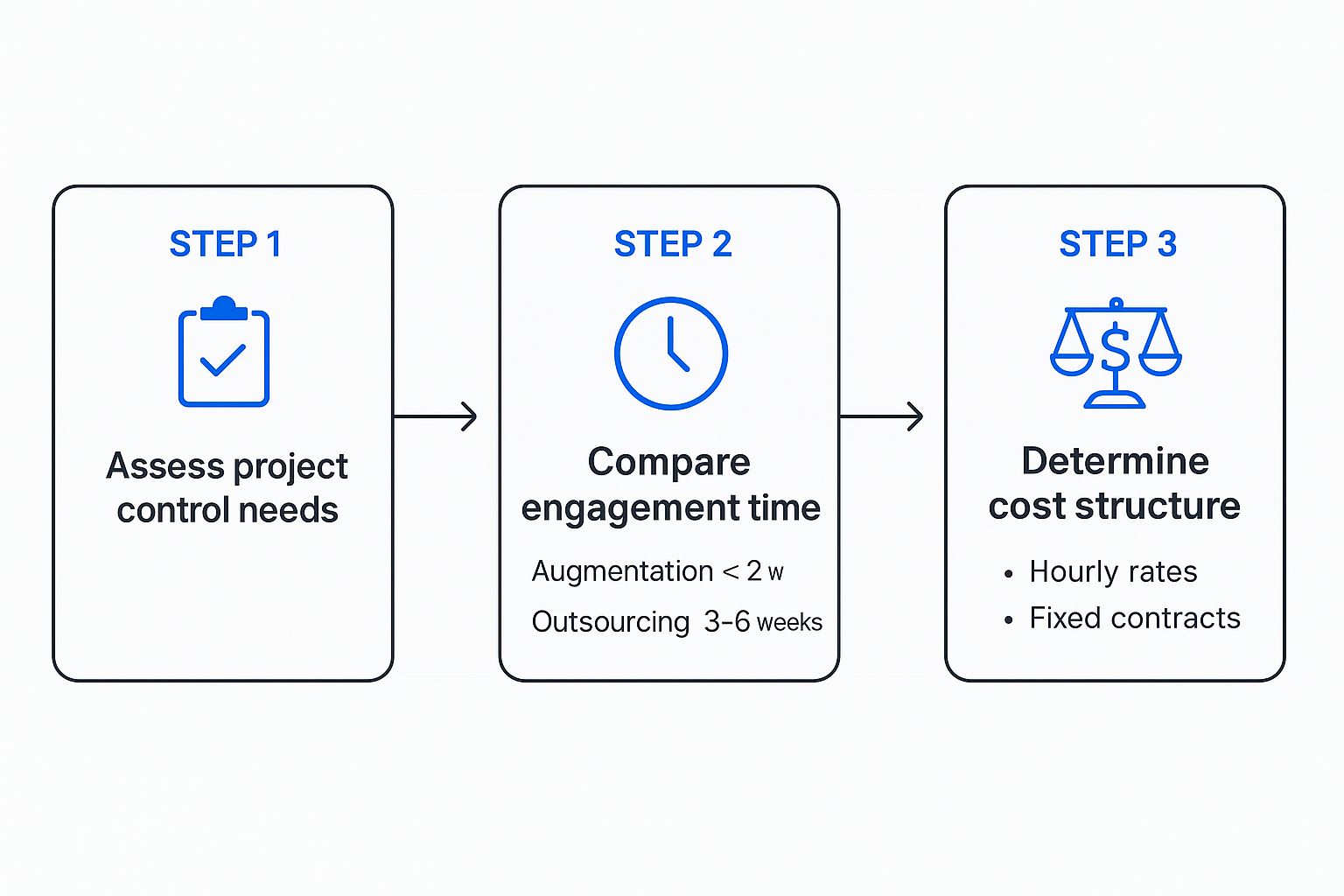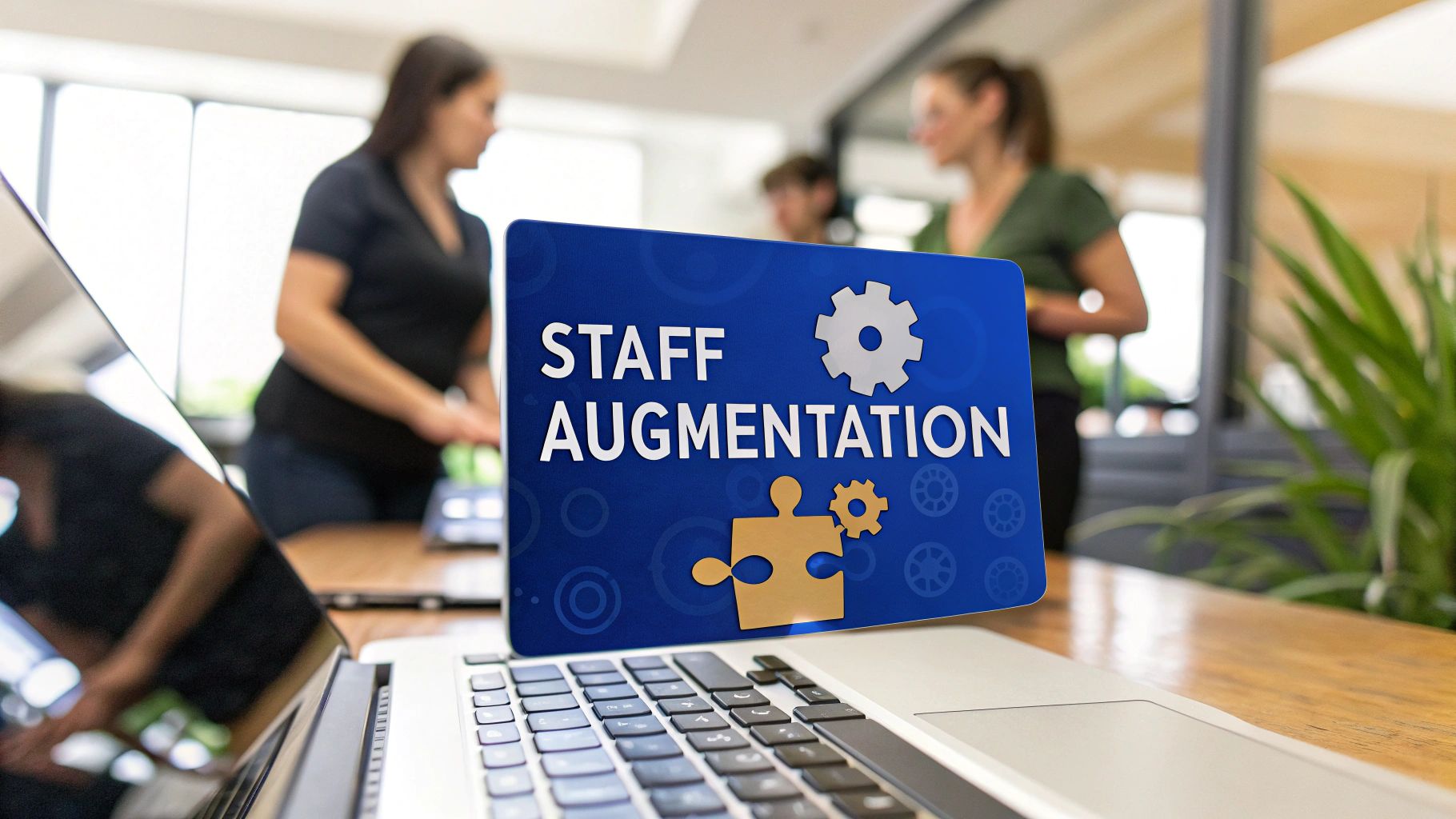Let's get straight to it: what exactly is staff augmentation?
Think of it like this. You're renovating your kitchen, and you’ve got a solid team for the plumbing and electrics, but you're missing a specialist tiler. Instead of hiring a whole new construction crew, you bring in just the tiler – an expert who can seamlessly slot into your existing team and get that specific job done. That’s the essence of staff augmentation. It’s a smart outsourcing strategy where you hire pre-vetted, skilled professionals to work alongside your in-house team on a temporary basis, plugging a specific skill gap right when you need it.
Getting to Grips with the Core Idea

The real magic of staff augmentation lies in two things: precision and control.
Unlike traditional outsourcing where you hand over an entire project and its management to another company, this model keeps you firmly in the driver's seat. The specialists you bring on board report directly to you. They follow your internal processes and, for all intents and purposes, become a natural extension of your team for the duration of their contract.
This gives businesses an incredible amount of agility. You can scale your workforce up or down almost on demand, accessing the exact talent you need without the drawn-out recruitment cycles and overheads that come with a permanent hire. It’s a powerful way to handle the natural ebb and flow of project work and sudden market shifts. The numbers back this up, too. The global IT staff augmentation market was valued at an estimated $299.3 billion in 2023 and is forecast to soar to nearly $857.2 billion by 2031. If you're curious, you can explore more about these IT staffing trends and future predictions to see how other companies are adapting.
How It Stacks Up Against Other Staffing Models
To really appreciate what staff augmentation brings to the table, it’s helpful to see how it compares to other common ways of bringing in talent. Each approach has its place, and the best fit always comes down to your project goals, budget, and how much control you want to keep.
The crucial difference is integration. Staff augmentation brings external talent inside your existing team structure. Outsourcing, on the other hand, delegates entire projects to an external team that manages itself.
To make this clearer, let's break down the key differences.
Staff Augmentation Vs Other Staffing Models
This table offers a quick comparison, showing how staff augmentation stands apart from managed services (a form of outsourcing) and hiring freelancers.
As you can see, this unique blend of flexibility, specialised expertise, and direct oversight is precisely why so many businesses are turning to staff augmentation. It offers a middle ground that delivers the best of both worlds.
Key Benefits Of Staff Augmentation For UK Businesses

When you strategically bring specialists into your existing team, the ripple effects go far beyond just filling an empty seat. For UK businesses trying to get ahead, staff augmentation isn't just a buzzword; it’s a powerful tool that has a real, measurable impact on your budget and project deadlines.
One of the first things you'll notice is how much you save on hiring. The traditional route is notoriously expensive and slow. You're paying for job adverts, spending countless hours in interviews, and wading through paperwork. Staff augmentation cuts right through that, putting you in touch with pre-vetted professionals who are ready to hit the ground running.
This speed is a game-changer for getting projects over the line. Instead of a months-long wait to hire and train someone new, you can have a specialist integrated into your workflow in a matter of weeks. That kind of agility means you can pounce on market opportunities and deliver for your customers without delay.
Accessing A Global Talent Pool
Maybe the biggest win is the instant access you get to a global talent pool. This is a huge deal right now, as the UK is facing a serious tech talent shortage, especially in areas like software engineering, DevOps, AI, and cybersecurity. Staff augmentation provides a direct line to top-tier professionals from around the world, letting you sidestep the frustratingly long local recruitment cycles.
Tapping into global talent also frees you from the limitations of local salary expectations and skill shortages. It opens up a world of possibilities, letting you find the exact expert you need for your project, no matter where they are. Our guide to remote staffing solutions has some great insights on building these kinds of effective, distributed teams.
Staff augmentation gives you a tactical advantage. You get the precise skills you need, for the exact time you need them, all without the long-term financial weight of a permanent salary.
This model delivers some incredible financial and operational flexibility. Let's break down how that actually works for you.
- Cost Efficiency: You neatly sidestep the overheads that come with permanent hires—things like benefits packages, pension contributions, and National Insurance. It’s a smart way to manage expenses, and you can explore more strategies on how to reduce recruitment costs.
- Scalability on Demand: Your team can grow or shrink as your project needs change. This means you’re only ever paying for the expertise you're actively using, which makes budgeting so much cleaner.
- Reduced Risk: Because your augmented staff come through a partner agency, the risk of making a bad hire is massively reduced. The agency has already done the hard work of vetting, so you can be confident you're getting a qualified and reliable professional.
By bringing these benefits together, UK businesses can keep their core teams lean and focused while still having the muscle to scale up with specialist talent whenever a project calls for it. It's how you stay agile and competitive in a fast-moving market.
How The Staff Augmentation Process Works Step-by-Step
So, how does staff augmentation actually work in practice? The whole process is built for speed and accuracy, letting you move from spotting a skill gap to bringing an expert on board much faster than with traditional hiring. Think of it as a clear, well-trodden path for adding external talent directly into your team.
It all kicks off with a critical first step: defining your exact needs. This is much more than just saying, "We need a developer." You have to get specific. What tech stack are we talking about? What level of seniority do they need? How long is the project? And, importantly, what kind of personality will click with your existing team? A detailed blueprint here is the foundation for finding the perfect fit.
Finding the Right Partner
Once you have a crystal-clear picture of your ideal candidate, you bring in a specialist agency. Instead of you drowning in a sea of CVs, you hand over your detailed requirements to a firm that lives and breathes talent acquisition. This is where things really start to pick up speed.
The real magic of a good partner is their pre-vetted talent pool. They aren't starting from scratch every time. They're matching your needs against a curated network of professionals whose skills, experience, and reliability have already been checked.
A solid agency acts as your strategic filter, handling all the initial legwork of sourcing and screening, which saves your team an enormous amount of time. If you want to get the most out of this relationship, it's worth understanding how to work with recruitment agencies to build a truly productive partnership.
This visual breakdown shows just how much faster staff augmentation can be compared to other models.

As you can see, the efficiency is striking. It's often possible to have a new team member ready to go in under two weeks.
From Selection to Integration
With a shortlist of qualified candidates in hand from your partner, your team takes over for the final vetting. You run the interviews, the technical tests, and the cultural fit chats. Crucially, you have the final say on who joins your team, so you never lose control over who you're working with.
The last few steps are all about smooth onboarding and management:
- Onboarding: Your partner agency usually takes care of all the contracts and payroll paperwork. Your job is to get the new team member plugged into your project tools, communication channels, and daily routines.
- Integration and Management: From day one, the augmented professional works under your direct management. They become a genuine part of your crew—you assign their tasks, oversee their work, and include them in stand-ups just like anyone else on your payroll.
This structured, yet flexible, approach means you can get a highly skilled person contributing to your project in a fraction of the time it would take to hire someone permanently. It's what makes the whole model so incredibly efficient.
Making Smart Choices For Your UK Business

Successfully bringing augmented staff into your business is about more than just finding someone with the right technical skills. For UK companies, it’s a strategic move that needs to carefully balance costs, compliance, and company culture. Get it right, and you don't just fill a skill gap—you build a real competitive edge.
One of the first hurdles is the legal stuff, especially GDPR. When you bring in talent from around the world, you’re still responsible for protecting any data they access. This is where a good augmentation partner proves its worth. They should already have robust, compliant processes in place, taking that headache away from you.
This legal responsibility feeds directly into your sourcing strategy. For UK businesses, particularly in tech, making smart choices about how you source talent is essential to master project management for software development.
Onshore Vs Offshore Augmentation For UK Firms
Deciding where your augmented staff are located is a major fork in the road, with each path offering different benefits and challenges. Let's break down the pros and cons of keeping it local versus going global.
Ultimately, there's no single "best" answer. An onshore team is fantastic for projects needing tight, real-time collaboration. But an offshore team can unlock significant cost savings and give you access to specialised skills you might not find in the UK. Many businesses find a hybrid approach gives them the best of both worlds.
The real goal isn't just to hire a contractor; it's to build a single, high-performing team. When integration is done right, a temporary team member becomes a truly valuable asset.
Your Success Checklist
To avoid common pitfalls and get the best return on your investment, you need a solid integration plan. Just sending over a login and a project brief won’t cut it. Success comes from making your new team members feel like they belong from day one.
Here’s a practical checklist to get you started:
- Set Clear Communication Rules: Decide how, when, and where your team will connect. This means setting clear expectations for daily stand-ups, response times on Slack, and video call etiquette to make everyone feel included, no matter where they are.
- Make Security a Priority: Your augmented staff need proper training on your company's security policies. Use role-based access controls to make sure they can only see the data they absolutely need to, protecting your sensitive information.
- Build an Inclusive Culture: Make an active effort to bring augmented staff into the fold. Invite them to virtual coffee mornings, pair them with a buddy from your core team, and give them public shout-outs for their work.
By thinking through these elements—compliance, sourcing, and integration—your UK business can do more than just plug a skills gap. You can build a flexible, powerful team that’s ready to deliver fantastic results.
Our Approach To Staff Augmentation
Knowing what staff augmentation is on paper is one thing. Finding a partner who actually gets it right—with genuine care and precision—is another challenge entirely.
Let’s be honest, many augmentation services are little more than glorified CV databases. They flood your inbox with résumés, leaving you to do the heavy lifting of sifting through a mountain of candidates who are often a poor fit. That’s not our style.
We built our model on a simple but powerful idea: a true partnership comes first. We don't just fill seats. We invest real time in understanding your project goals, your team's unique dynamic, and the specific hurdles you're trying to overcome. This way, the talent we provide feels less like a temporary fix and more like a natural extension of your own team.
Accessing The Top 5% Of Talent
Our commitment to you starts with an uncompromising focus on quality. We grant you exclusive access to the top 5% of global talent—not just whoever happens to be on the market.
How do we do this? Through a rigorous, multi-stage vetting process that goes miles beyond a basic skills checklist. We assess everything from deep technical proficiency and creative problem-solving to communication skills and professional reliability.
A successful placement is about more than just technical skill; it’s about finding a professional who can integrate seamlessly and contribute meaningfully from day one. That’s why our process is designed to find the perfect fit, not just a close one.
This painstaking screening means that when we introduce a candidate, you can trust they are one of the best in their field, ready to make an immediate and positive impact.
Matching Culture As Well As Code
We've learned that a new team member's ability to fit into your company culture is just as critical as their technical prowess. A skills mismatch might slow a project down, but a cultural mismatch can derail it completely. That’s why cultural alignment is a cornerstone of our selection process.
We take the time to learn your company's ethos, its communication style, and its unique workflow. This allows us to find a professional who won't just do the work, but will also blend in effortlessly with your existing team.
This dual focus on both technical skill and cultural fit delivers some key advantages:
- Seamless Integration: New members feel like part of the team almost instantly, which nurtures better collaboration and morale.
- Increased Productivity: When someone is a great cultural fit, they're naturally more engaged and motivated, producing higher-quality work as a result.
- Reduced Management Overhead: You get to spend less time navigating personality clashes and more time focused on hitting your project goals.
To top it all off, we handle the administrative headaches. From contracts and payroll to navigating international compliance, we manage all the backend details. This frees you up to concentrate on what you do best: guiding your project to success. Our model is designed to be a risk-free, efficient solution for organisations that demand world-class talent without compromise.
Frequently Asked Questions About Staff Augmentation
Even after getting your head around the concept, it's natural to have a few practical questions pop up when you think about using staff augmentation in your own company. To help iron out those last few wrinkles, we've tackled some of the most common questions we hear. This should give you a better feel for how the model works and whether it’s the right move for your team.
How Quickly Can I Onboard An Augmented Staff Member?
Speed is one of the biggest draws of staff augmentation. Honestly, the whole process is built to be a lot faster than the typical hiring grind. Most of the time, you can have a fully qualified professional ready to work with your team in as little as one to two weeks.
How is that possible? Well, specialist partners aren't starting from square one. They have a pre-vetted talent pool on standby, full of skilled people ready for their next challenge. This is a world away from the months it can take to post a job, sift through résumés, interview candidates, and finally bring someone on board.
Who Manages The Augmented Team Member?
This is a really important distinction, and the simple answer is: you do. This isn't like outsourcing where a vendor manages their own people and just hands you a finished product. With staff augmentation, the new team member reports directly to you or one of your managers.
You're in complete control of their day-to-day tasks, the project's direction, and how they fit into your workflow. They join your team meetings, use your internal systems, and basically become a seamless part of your crew.
This direct line of management makes sure they're completely in sync with your project goals and company culture from the get-go. It keeps collaboration smooth and leaves you firmly in control.
What Happens If The Augmented Staff Member Is Not A Good Fit?
It's a fair question, and it's something any good staff augmentation partner has a plan for. A quality provider, like us at Beyond Hire, puts a massive emphasis on getting the fit right—both technically and culturally—to avoid this happening in the first place.
But let's say it does happen. If a placement just isn't working out or meshing with the team, the agency will jump on it immediately. They'll talk with you to pinpoint the problem and then find a replacement quickly, so your project doesn't lose steam. This is a core part of the service; think of it as a built-in safety net. Getting that initial fit right is also a cornerstone of our employee retention strategies, which help build productive, long-lasting working relationships.
Is Staff Augmentation Only For Short-Term Projects?
Not in the slightest. While it’s fantastic for filling short-term gaps or getting through a crunch period, many companies use staff augmentation for long-term engagements. It's an incredibly flexible model.
You might use it to bring in niche skills for a project that will run for years, especially if you don't need that role permanently within the company afterwards. It's also a smart way to tap into expertise that's either too expensive or simply unavailable in your local area. Whether your project is set for three months or three years, the model can be shaped to fit what you need.

